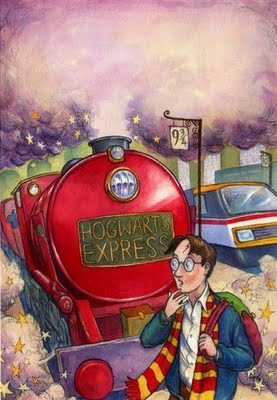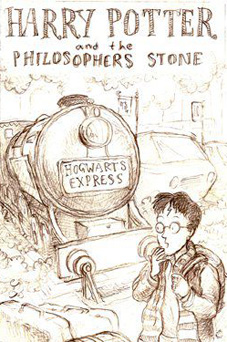Some years ago I came across a blog post about me, in which I was described as a missing person. It was slightly chilling to find myself discussed as a mysterious and vanished figure – someone who had done one notable thing and then dissolved into obscurity. It left me wondering if I had taken playing down my connection to the world of Harry Potter a little too far. But, in case you are still wondering what that connection is: I, Thomas Taylor, did the cover art for Harry Potter and the Philosopher’s Stone by JK Rowling.
Not, it’s true, for all the titles, and yes, different artists provided the artwork for the US, and for many editions around the world, but most people with a long interest in the Wizarding World created by JK Rowling will recognise this picture.
 Of course, one book cover does not a career make, though with this particular book cover it can sometimes be hard to persuade people of that. The fact is, this image has long been something for me to live down as much as it is something to be proud of, and the idea that it might be the crowning glory of my working life (hinted at by some, even now) is not appealing. How can it be when it was my first ever professional commission?
Of course, one book cover does not a career make, though with this particular book cover it can sometimes be hard to persuade people of that. The fact is, this image has long been something for me to live down as much as it is something to be proud of, and the idea that it might be the crowning glory of my working life (hinted at by some, even now) is not appealing. How can it be when it was my first ever professional commission?
This was way back in 1996. I’d left art school a year earlier and was working at Heffer’s Children’s Bookshop in Cambridge (UK), paying the bills (kind of) and finding out about the children’s book market. I had no agent at the time and few contacts, but being surrounded by kid’s books every day made it easy to decide where I should send samples of my work. I noticed that Bloomsbury were creating a children’s list at the time, so I went to London and left my portfolio with them. They must have seen something they liked because they gave me a book jacket to do.
People often ask why I wasn’t paralysed with the pressure of producing the cover art for one of the most famous books in the world. But these people forget that at the time J. K. Rowling was as unknown as I was, and it must have seemed a fairly simple thing to marry up her text with my illustration style, such as it was.
And what was my style? Well, back then it had only seat-of-the-pants consistency, and my samples were all over the place in terms of age-range. I wasn’t yet sure if I should aim for the scant illustration opportunities of older fiction and book jackets, or go all out for the little ones and become a picture book artist. At the time I had no real notion of writing myself, though deep down I wanted to. Anyway, I think there was a dragon or two among my samples so Harry Potter was mine.
Naturally I was quite excited. My first illustration job – Yay! I expect I bought some new pens to celebrate, and maybe a moderately-priced bottle of Belgian beer. There was an incomplete manuscript to read, roughs to do, and then the painting. The final image — a pencil sketch, painted with concentrated watercolour and then outlined with a black Karisma pencil — took two days, and all things considered I was quite pleased with it. I think I delivered it by hand.
 This was the only Harry Potter cover I did. Quite understandably, once the books took off — and considering that the stories progress in age through Harry’s school career — Bloomsbury turned to more experienced illustrators with a track record of art for this age range. By then I was working on my first picture books anyway, alienating myself from Harry’s readers. So, I don’t have any great regrets about losing out to Cliff Wright, et al, or about the briefness of my very brief involvement with HP.
This was the only Harry Potter cover I did. Quite understandably, once the books took off — and considering that the stories progress in age through Harry’s school career — Bloomsbury turned to more experienced illustrators with a track record of art for this age range. By then I was working on my first picture books anyway, alienating myself from Harry’s readers. So, I don’t have any great regrets about losing out to Cliff Wright, et al, or about the briefness of my very brief involvement with HP.
Except, hold on – I do have one regret.
As everyone knows, very few first edition hardbacks were published. I think the figure usually given is 450. Well, partly because of my connection with the book, we had ten of those hardbacks in the Children’s Bookshop. Ten! And do you know how many I bought?
None.
Yes, you read correctly, I didn’t buy a single copy of what would go on to be a highly valuable collector’s edition. The reason is simple: Bloomsbury were going to send me a signed copy and so I waited for that. Remember, there was no reason to think that this was anything other than just another children’s book, and hardbacks are pretty pricey for artists just starting out.
One of the worst things about working in a children’s bookshop during the rise and rise of Harry Potter was that all my colleagues knew about my connection with it. This was fine on the whole, but some of them couldn’t stop themselves from telling the customers. I’m sure you can imagine the looks of confused suspicion on the punters’ faces as their friendly but scruffy bookseller was pointed out as the cover artist of a book that was on everyone’s lips. I even remember being jostled into signing the cover for a few people, despite the fact that they clearly didn’t believe it. And when you are an artist of any kind, struggling to leave your day job, being asked ‘but why are you still here then?’ by perfect strangers is not good for morale.
And it didn’t end when I got home. At some point during the over-heated excitement that blew up when Harry Potter went hypersonic, the press started to take an interest in me. Which means that they must have been pretty desperate for some unusual angle on the story. I remember one man calling to say that he’d seen an early sketch I’d done and that Harry’s thunderbolt wasn’t there! Was he on to the scoop of a lifetime? No, sadly for him it was mere oversight.
On another occasion I was a bit foolish and started telling a half-truth to a journalist who had called (from Canada, I think) out of the blue. Now, by chance my depiction of HP bears a slight resemblance to someone I used to know. This really is a coincidence, but having been asked repeatedly ‘where did you get your ideas from?’, and noting that ‘from the text’ was never the desired answer, I started to tell this voice on the phone that Harry was ‘more or less’ based on a real person. A mental alarm bell rang, a moment too late, and I quickly ended the conversation, with breathless squeaks of protest from the handset as I hung up. But I’d heard what the journalist had in mind: he wanted to send a photographer to this person’s house and reveal to him that he is Harry Potter! What fun! I’m told the phone rang every three minutes for the rest of the day, but I was in the pub.
I’m complaining about this I suppose, though really it was easy to dodge the calls, and in any case they died down shortly afterwards. And it was even easier to turn down the chance to be on TV quiz shows, or address the Oxford Union (I’m not kidding), or any of the other crazy suggestions that came my way. I remember a journalist writing at the time that there was ‘a culture of secrecy’ surrounding Harry Potter. Was there? If so, then I suppose I contributed to it.
I was able to leave the bookshop by the end of the century, a fully fledged (feather-brained?) picture book illustrator. I have no way of telling how many doors were opened for me as a result of my small connection with HP, or how many slammed shut; I don’t think about it. I admired the author at the time for giving 9 to 12-year-olds precisely what they needed: a bit of enchantment and a refuge from pressure, anxiety and homework. These days I aspire to conjure the same enchantment with my own writing.
In conclusion then, Harry Potter gave me a magical start to my career and I’m very grateful to him for that. But I hope this short piece illustrates why I haven’t always wanted to ride the broomstick myself. Harry also gave me my fifteen minutes of bar-room fame, one Cambridge evening during the now legendary ‘Bird in Hand’ pub quiz. The quiz master, who didn’t know me at all, asked ‘how is Thomas Taylor related to Harry Potter’s J. K. Rowling?’ I was stunned, but at least I knew the answer. Now you do, too.
Find out more about my brush with the magical world of Harry Potter in this Observer article, and this interview on the excellent Mugglecast podcast.
